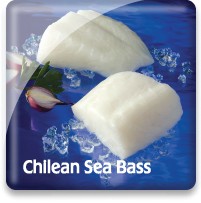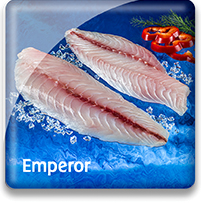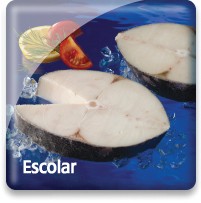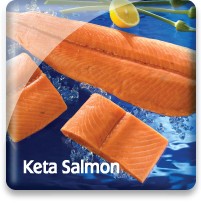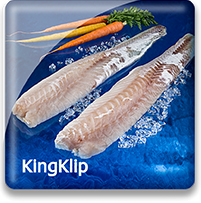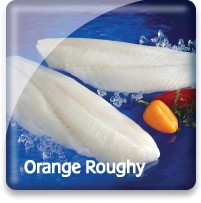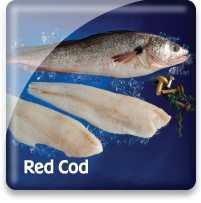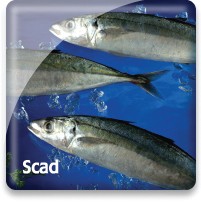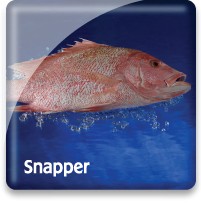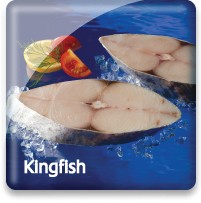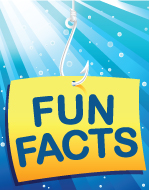
Pollock

Market Name: Eating QualitiesAlaska Pollock has a delicate mild flavor. When cooked, the flesh of the fish is snow-white. It is lean and tender with excellent flaking quality. It should not be confused with Atlantic Pollock which is a darker, more oily meat that typically has a “fishier” flavor.
Young pollock can grow up to 13 cm a year.
|
Description & CharacteristicsPollock has been a standard choice for a white, mild and flaky fish. It’s primary use has been in value-added seafood products, like breaded fish sticks. Commercial processors of Pollock fillet produce large amounts of Pollock blocks and surimi blocks. Pollock represents almost 10% of the world’s harvested fish. Russian caught Pollock is frozen on board its catch vessel in H&G, then re-processed in China into fillets. Treating twice-frozen Pollock fillets with a Sodium Tripolyphosphate solution to help preserve quality and moisture is standard in the industry. It is important seafood buyers know their suppliers well to ensure proper treatment and net weight of the product. In late 2015, a federal law was passed that restricted the marketing name of "Alaska Pollock" only for pollock caught in waters under federal and state jurisdictions. This made it illegal for Russian caught product to be called "Alaska Pollock".Pollock Fillets are mild in flavor with slight coarse texture. Boneless fillets are cream in color. Cooked, the fillet is white, firm and flaky. Pollock is one of the major groundfish resources of the world, and by far the most important groundfish species harvested in the North Pacific. Originally marketed as a less expensive alternative to cod and haddock, this abundant fish now has a well established market and is the world’s most consumed whitefish. Pollock is a brownish-green mottled fish with white sides and belly, which usually range in size from one to four pounds dressed, has a whiter flesh, milder flavor and less oil than pollock fished in the Atlantic, which is a different species. The U.S. Alaska Pollock fishery is really two fisheries; the Gulf of Alaska fishery and the larger and dominant Bearing Sea-Aleutian Island fishery. Both are well managed and have attained MSC certification. The fishery is a mid-water trawler fishery with onshore processing, but is set apart from other U.S. fisheries by the use of catcher/processor vessels that produce and freeze a variety of products at sea. In the U.S. fishery pollock is landed from January through March in the “A” season which includes roe harvesting, and June through October in the “B” season. The smaller Gulf of Alaska fishery has slightly different seasons. For the past 20 years, Alaska pollock harvests in the U.S. have averaged 1.22 million metric tons per year. In recent years, the Total Allowable Catch (TAC) for U.S. Alaska pollock has been set lower by fishery managers after their review of annual scientific surveys of the fishery. Scientists predict that the TAC will increase in the future.After declining since the late 90s, the Russian pollock fishery in the Bering Sea and Sea of Okhotsk historically larger than the Alaskan fishery, has recently been improving, especially in the Sea of Okhotsk. The Russian fishery supplies much of the raw material to Chinese producers which is then processed and shipped all over the world as twice-frozen products. Single frozen Russian pollock production is increasing,. As of late 2015, only one Russian Pollock (can't be called "Alaska Pollock") fishery had attained MSC certification. The Alaska pollock fishery is the largest food fish fishery in the United States and has a global distribution of a wide range of products. Automated machinery heads, dresses and fillets the fish at the lightning fast speed of 120 fish per minute. The fillets then move to the packing station where they are assembled into 16.5 lb. freezer pans and then flash frozen into what is known as fillet blocks to the commodity buyers. The frozen fillet blocks are the raw material used to make breaded or seasoned fish portions, sandwich portions, and fish sticks—all of which are primarily consumed in the North American and European markets. A small percentage of the catch is processed as IQF fillets and layerpack blocks which allow fillets to be used individually. The vast majority of pollock fillet products from Alaska are single-frozen, with the small, but growing, H&G production being shipped to China for further processing.Other fillets and trim pieces are produced into surimi, a minced fish protein that is used as the base ingredient in crab flavored surimi seafood in North America, Europe, Japan, South Korea, China and S.E. Asia. In addition, a wide variety of surimi-based kamaboko products are consumed mostly in Japan and South Korea but also are finding interest from consumers in North America and Europe in small quantities. Alaska pollock is a well utilized fish; the Roe (eggs—sometimes known as caviar), Milt (sperm) and Chu (stomachs) are all eaten as delicacies in Japan, South Korea and with growing consumer interest in North America and Europe. In some cases these products are more valuable than the fillets.Even the heads, skin and bones are not wasted. These items are rendered in the processing plant or onboard the vessel to produce some of the highest quality fish meal for aquaculture feed in Asia and fish oil which can be used in the production of nutritional supplements (omega-3) or more recently as a biofuel for operating boilers and diesel engines.
Other Resources |
Handling Instructions for Pollock
Frozen pollock fillets should be stored at or below 0°F (-18°C) and then thawed properly when ready to cook. The frozen shelf life of our IQF pollock is 18 months. Links to proper seafood handling instructions: NOAA - Fish Watch: Handling Seafood and A Consumer Guide to Safe Seafood Handling.
Thawing Pollock
Thawing is accomplished by placing the fillets in a sealed plastic container or bag and placing in the refrigerator (33 to 39°F) for 12-24 hours. This is our recommended thawing method for fillets. Fillets that are not consumed promptly after thawing need to be refrigerated between 33 and 39°F and totally consumed in 2-3 days.
Important Instructions for Pollock
Consuming the fillets immediately after proper thawing yields the best quality.
The Federal Food, Drug and Cosmetic Act now requires that all foods that are not raw agricultural commodities and that contain a major food allergen be labeled to clearly identify the name of the food source form which the allergen is derived. (21 CFR U.S.C. 343(w)(1)). The act defines eight foods, and any ingredients derived from these foods as major food allergens: Fish, Crustacean Shellfish, Milk, Eggs, Tree Nuts, Peanuts, Wheat & Soybeans. The name of the food source that must be listed on the label for fish or crustacean shellfish must be the specific type of fish or crustacean shellfish. The market names of species of fish and crustacean shellfish should be used to identify the food source of these two major food allergens. If you intend to re-pack these seafood products, be sure the allergen is declared in either one of two ways:
1) Within the list of ingredients
or
2) In a separate “Contains” statement immediately after or adjacent to the list of ingredients.
Consult the Fish and Fishery Products Hazards and Controls Guidance, Fourth Edition, Chapter 19 for more detailed information on the labeling of food allergens.
Cooking Tips
Pollock fillets can be prepared using a wide variety of cooking techniques. Links to pollock fillet cooking tips and recipes.
Russia
Russia is the largest country in the world. It stretches from the Baltic Sea in the east to the Pacific Ocean and from the Arctic Ocean to the Black Sea in the South. It is nearly twice the size of the United States. The rule of law and the regulation and management of fisheries and aquaculture is weak when compared to Canada, the U.S., and other developed countries. Russia is in the top ten of the world’s fishery producers and most of this wild catch comes from the Pacific Ocean region in the areas of the Okhotsk Sea, the Bering Sea, and around the Kamchatka Peninsula. Fishery and aquaculture management is administered by the Federal Agency for Fisheries. The Russian wild fishery harvest includes over 100 commercial species of finfish and invertebrates of which pollock, herring, salmon, king crab, snow crab, and groundfish are the most important. Trout, salmon, carp, sturgeon, whitefish, and scallops are the primary items produced by Russian aquaculture. Progress improving responsible practices for both the Russian wild fisheries and the aquaculture sector has been difficult and slow. Most of the progress has been spearheaded by NGOs working with various Russian commercial fishing federations to improve the sustainability of the king crab and pollock fisheries. In September of 2013 their pollock was MSC certified as sustainable. Illegal, unreported, and unregulated (IUU) fishing is currently an ongoing problem with the poorly regulated Russian fishing industry.
China
With more than 1.3 billion people, China is today the world’s most populous country. With a growing economy fueling an appetite for seafood, China has begun importing seafood for in-country consumption, as well as exporting a great deal of its production. In fact, since 2002, China has continued to export more fish and fishery products than any other country in the world, with Japan, the United States, and the Republic of Korea as its main export markets.
Chinese distant water fishing activities started in 1985 when China gained access to new fishing grounds through agreements with foreign countries. China operates vessels in West Africa, the North Pacific, and tuna longline vessels in the South Pacific. In addition, squid are harvested in the Japan Sea, the South Atlantic, and the North Pacific under Chinese-flagged vessels.
Carp are also commercially important, as are bream, shad, eel, catfish, rainbow trout, salmon, whitebait, mullet, mandarin fish, perch, sturgeon, and murrel (snakehead). Commercial shellfish include Saltwater & freshwater shrimp, river crabs, and mollusks such as mussels, clams, oysters, and freshwater snails.
With one-fifth of the world’s population, and an official government policy to promote aquaculture, China has today become an aquaculture powerhouse, now producing more than two-thirds of the world’s aquaculture species. Fish and shellfish are grown in freshwater and saltwater environments.
http://cport.net/go-blue-seafood-sustainability-spectrum
Go Blue! Seafood Sustainability Spectrum*Click here for an explanation of our Sustainability Spectrum 
Sustainability AssessmentPollock is currently the fifth most popular seafood in the U.S (behind tilapia). The Pollock fishery is one of the largest in the world, with the majority of the fishery taking place in the US and Russia. Sea Port currently sources Pollock from the Russian fishery that is processed in China. As of late 2015, federal law restricted the marketing name of "Alaska Pollock" only to product caught in U.S. waters. Russian caught pollock can therefore not use the marketing name "Alaska Pollock". The Russian Sea of Okhotsk fishery successfully completed the MSC certification process in September 2013 and was declared to be responsibly managed and sustainable.
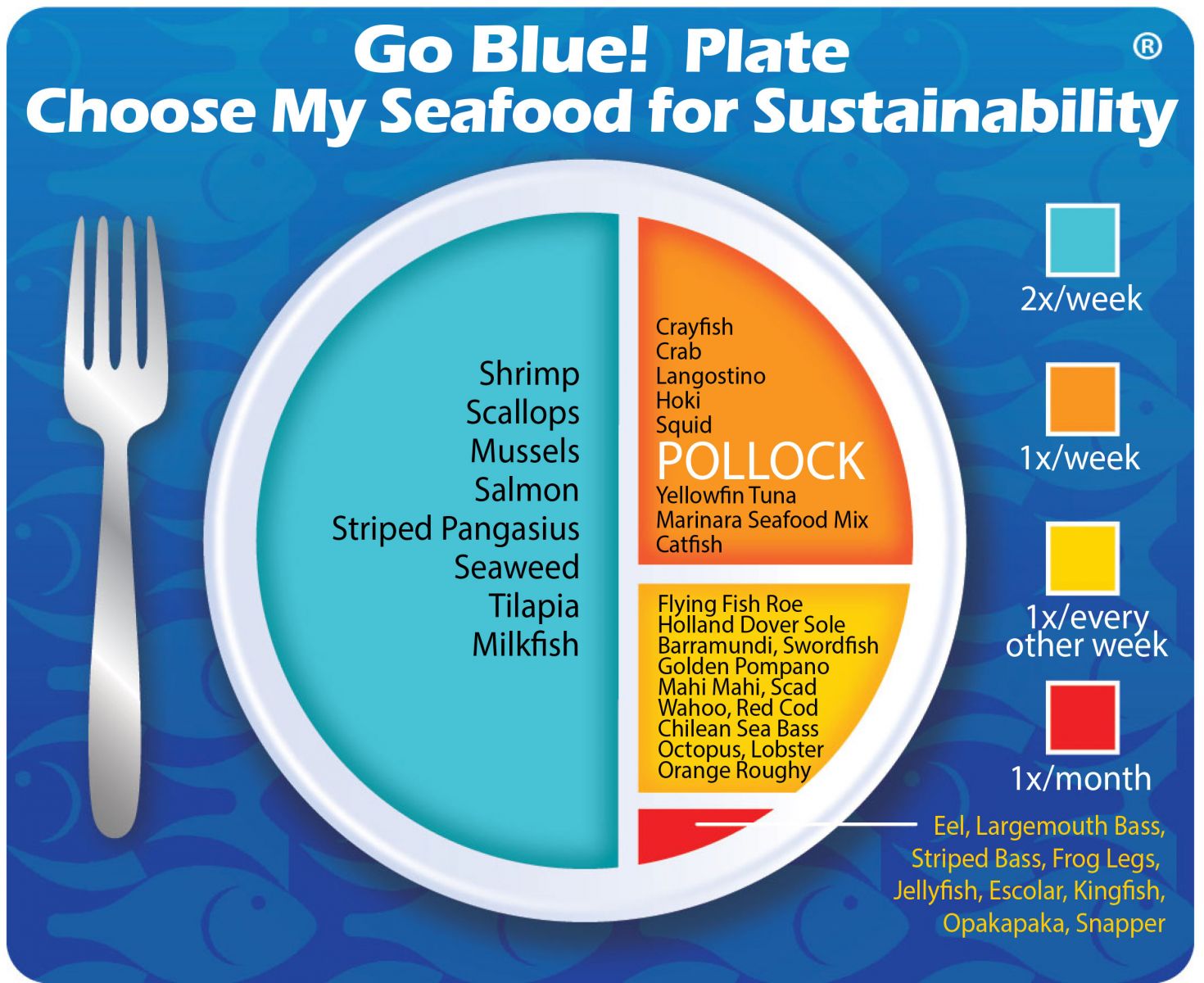
Environmental Impact: Low to ModerateThe MSC certification addressed the Russian pollock fishery regulatory structure, ecosystem/socioeconomics impacts, bycatch, stock assessment, and the quota system and concluded that the Sea of Okhotsk Pollock fishery is sustainable. The two remaining major fishing areas in Russia may seek to attain MSC certification.
Sustainability Improvements NeededAdditional information is needed on bycatch, impacts on sea floor habitats, and observer monitoring.
Actions that Sea Port is UndertakingSea Port is continually monitoring this fishery to see if there are additional improvemnts that can enhance or improve upon the current MSC standards so the pollock needle on our Go Blue Seafood Sustainability Spectrum can be further advanced towards the ideal goal of perfect sustainability. Sea Port believes that, in aggregate, choosing from a diverse variety of seafood is better for sustaining the world’s seafood resources and that Pollock should be a part of this variety.
We created the sustainability assessments for each of our seafood items in order to reveal the existing and potential environmental impacts and risks that are associated with producing them for human consumption. This allowed us to establish the starting position for each of our seafood items along our progressive Go Blue! Seafood Sustainability Spectrum®. These assessments are only a single snapshot in time and because of this, we will continue to assess and update the critical sustainability needs associated with our supply sources and issue updates to the Go Blue! Seafood Sustainability Spectrum® as needed. There is a growing global awareness for the need to assure the sustainability of farmed and wild caught seafood and because of this; all around the world positive changes are rapidly occurring at all levels of the seafood supply chain. We will continue to spread this growing awareness and work with our many industry partners to improve the sustainability of all seafood, which we believe is the ideal protein of choice to feed an ever growing world population. Our Go Blue! Seafood Sustainability Spectrum® serves as our compass and yardstick as we strive to move all our products forward to becoming more sustainable. Please join us in this committed quest and Catch Our Wave® to sustainability by choosing a diverse variety of responsibly produced seafood as part of your diet.
|


